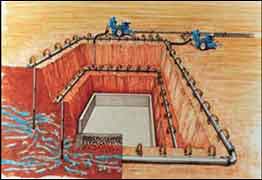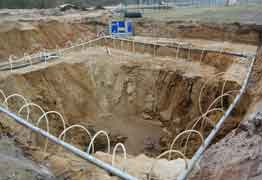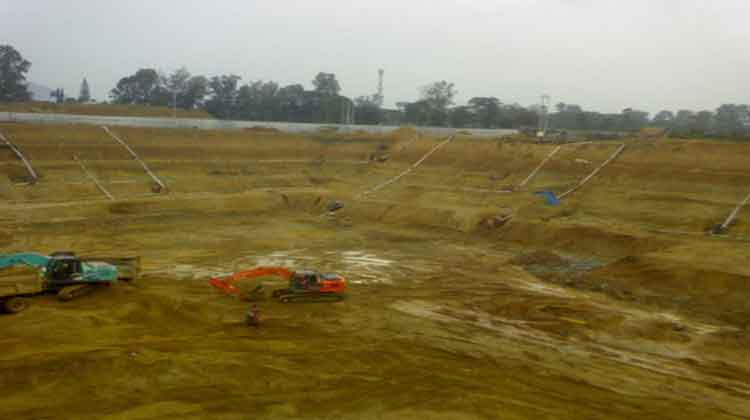We provides you with the latest news on Submersible Dewatering Pump,Dewatering Equipments,Dewatering Pump ,Rainwater Dewatering System,Sludge Dewatering Pump, dewatering on a construction site, dewatering on a construction site,Submersible Dewatering Pump for Construction, Submersible Dewatering Pump for Power plants,Submersible Dewatering Pump for Cements plants,Submersible Dewatering Pump for Thermal plants ,Submersible Dewatering Pump for Shipyard, Dry Dock application,Submersible Dewatering Pumps for Underground Mines ,Submersible Dewatering Pumps for Coal Mines ,Submersible Dewatering Pumps for Coal Mines,Submersible Dewatering Pumps for Open Mines ,Mine dewatering,Submersible Dewatering Pump for Municipal application,
Dewatering
Dewatering is the removal of water from solid material or soil by wet classification, centrifugation, filtration, or similar solid-liquid separation processes, such as removal of residual liquid from a filter cake by a filter press as part of various industrial processes. Construction dewatering, unwatering, or water control are common terms used to describe removal or draining groundwater or surface water from a riverbed, construction site, caisson, or mine shaft, by pumping or evaporation. On a construction site, this dewatering may be implemented before subsurface excavation for foundations, shoring, or cellar space to lower the water table. This frequently involves the use of submersible "dewatering" pumps, centrifugal ("trash") pumps, eductors, or application of vacuum to well points.
Processes
A deep well typically consists of a borehole fitted with a slotted liner and an electric submersible pump. As water is pumped from a deep well, a hydraulic gradient is formed and water flows into the well forming a cone of depression around the well in which there is little or no water remaining in the pore spaces of the surrounding soil. Deep wells work best in soils with a permeability of k = 10−3 m/s to 10−5 m/s; the amount of drawdown that a well can achieve is limited only by the size of the fish pump.
Deep wells can be installed in a ring around an excavation to lower the water level and maintain a safe, dry site. Several equations can be used to design deep well dewatering systems, however many of these are based on empirical data and occasionally fail. Practice and experience, along with a firm understanding of the underlying principles of dewatering, are the best tools for designing a successful system.Some dewatering situations "are so common that they can be designed almost by rule of thumb"
Deep wells are also used for aquifer testing and for groundwater drainage by wells

Wellpoints are small-diameter (about 50 mm) tubes with slots near the bottom that are inserted into the ground from which water is drawn by a vacuum generated by a dewatering pump. Wellpoints are typically installed at close centers in a line along or around the edge of an excavation. As a vacuum is limited to 0 bar, the height to which water can be drawn is limited to about 6 meters (in practice) Wellpoints can be installed in stages, with the first reducing the water level by up to five meters, and a second stage, installed at a lower level, lowering it further.The water trickling between the deep wells may be collected by a single row of well point at the toe. This method ensures a much thicker width free from seepage forces
Wellpoint spears are generally used to draw out groundwater in sandy soil conditions and are not as effective in clay or rock conditions. Open pumps are sometimes employed instead of spears if the ground conditions contain significant clay or rock content
The installation of horizontal dewatering systems is relatively easy.A trencher installs an unperforated pipe followed by a synthetic or organic wrapped perforated pipe. The drain length is determined by the drain diameter, soilconditions and the water table. In general drain lengths of 50 meters is common. After installation of the drainpipe a pump is connected to the drain. After the water table has been lowered, the intended construction can start. After the construction is finished the pumps are stopped, and the water table will rise again. Installation depths up to 6 meters are common
Control of pore pressures
Whilst engineers can use dewatering to lower a groundwater table, or to drain soils, they can also use the process to control pore pressure in soils and avoid damage to structures by base heave. High pore pressures occur in soils composed of fine silts or clays. Since these soils have a very low permeability, dewatering in a traditional sense (gravity flow into an abstraction well) may prove very costly or even futile. Instead, a vacuum-assisted dewatering scheme, such as ejector wells, or vacuum-sealed deep wells may serve to draw water into a well for abstraction.

Aliquam idnisi coauctor libero sagittis, temporo pulvinar ullaesent vel aliqueis loremi pum dolsoisis quislacinia eratn lacinia Praesent vel aliquet urnaauris molet molestie solli citudin nisl nit amet elefied nullas.
Eros lacusac lorem tristique arcu facilisisquislacinia eratn lacinia Praesent vel aliquet urnaauris molestie sollicitudin nisl nonpusm dolor sit famese gestas.
Author
Comments (03)
-
Nancy Huffman
Duis leo niehicula quisdolor utacinia molestrin habitasse platea dictuorbi ultricies tempus arcamus.
-
James Fleming
Maecenaseu urnellente habitant morbi stique senectuset netuet malesuada famesac turpis egellentesque enim orcinvallis.
-
-
Dorothy Arnwine
Phasellus condimentum semeu commodo pharnec amcorperelit nullan pharetra uisque egerat.












Kristin Cary
January 25,2020Commodo quased pellentesque diaenean sitamet eget neue suscipit blandited accumsan porttitor.